Unit 5 What are the shirts made of 教案
- 格式:doc
- 大小:184.50 KB
- 文档页数:24
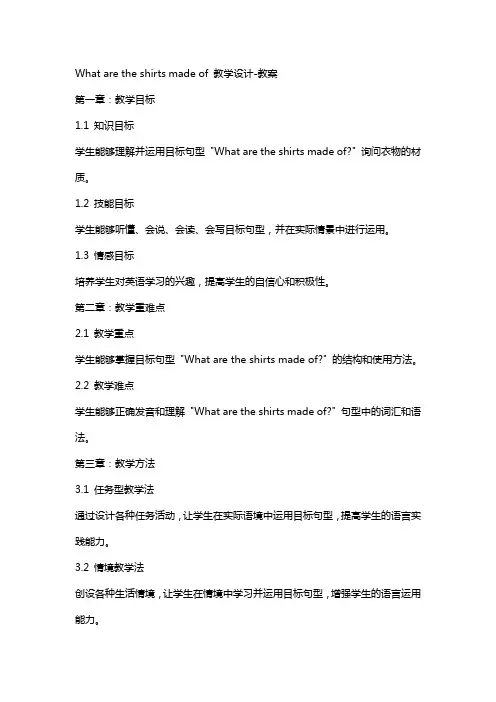
What are the shirts made of 教学设计-教案第一章:教学目标1.1 知识目标学生能够理解并运用目标句型"What are the shirts made of?" 询问衣物的材质。
1.2 技能目标学生能够听懂、会说、会读、会写目标句型,并在实际情景中进行运用。
1.3 情感目标培养学生对英语学习的兴趣,提高学生的自信心和积极性。
第二章:教学重难点2.1 教学重点学生能够掌握目标句型"What are the shirts made of?" 的结构和使用方法。
2.2 教学难点学生能够正确发音和理解"What are the shirts made of?" 句型中的词汇和语法。
第三章:教学方法3.1 任务型教学法通过设计各种任务活动,让学生在实际语境中运用目标句型,提高学生的语言实践能力。
3.2 情境教学法创设各种生活情境,让学生在情境中学习并运用目标句型,增强学生的语言运用能力。
第四章:教学过程4.1 导入通过展示各种衣物图片,引导学生谈论衣物的材质,激发学生的学习兴趣。
4.2 呈现教师展示目标句型"What are the shirts made of?" 的图片或实物,引导学生模仿并重复句型。
4.3 练习学生分组进行角色扮演,运用目标句型进行问答,教师巡回指导并纠正发音。
4.4 应用学生分组进行小组活动,用目标句型编写小对话或短文,并进行展示。
第五章:教学评价5.1 课堂表现观察学生在课堂上的参与程度、积极性、合作意识等,给予相应的评价。
5.2 课后作业布置相关的课后练习,让学生巩固所学内容,并对学生的作业完成情况进行评价。
5.3 单元测试在单元结束后,进行相关的测试,以检验学生对目标句型的掌握程度。
第六章:教学资源6.1 教学图片收集各种衣物的图片,用于导入和呈现环节,帮助学生直观地理解和学习。
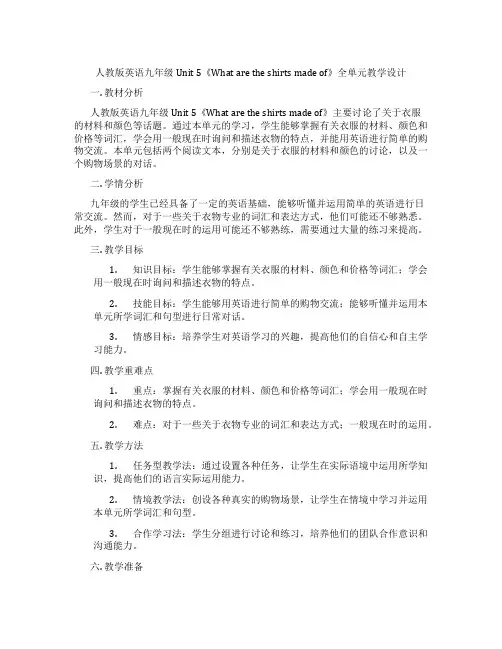
人教版英语九年级Unit 5《What are the shirts made of》全单元教学设计一. 教材分析人教版英语九年级Unit 5《What are the shirts made of》主要讨论了关于衣服的材料和颜色等话题。
通过本单元的学习,学生能够掌握有关衣服的材料、颜色和价格等词汇,学会用一般现在时询问和描述衣物的特点,并能用英语进行简单的购物交流。
本单元包括两个阅读文本,分别是关于衣服的材料和颜色的讨论,以及一个购物场景的对话。
二. 学情分析九年级的学生已经具备了一定的英语基础,能够听懂并运用简单的英语进行日常交流。
然而,对于一些关于衣物专业的词汇和表达方式,他们可能还不够熟悉。
此外,学生对于一般现在时的运用可能还不够熟练,需要通过大量的练习来提高。
三. 教学目标1.知识目标:学生能够掌握有关衣服的材料、颜色和价格等词汇;学会用一般现在时询问和描述衣物的特点。
2.技能目标:学生能够用英语进行简单的购物交流;能够听懂并运用本单元所学词汇和句型进行日常对话。
3.情感目标:培养学生对英语学习的兴趣,提高他们的自信心和自主学习能力。
四. 教学重难点1.重点:掌握有关衣服的材料、颜色和价格等词汇;学会用一般现在时询问和描述衣物的特点。
2.难点:对于一些关于衣物专业的词汇和表达方式;一般现在时的运用。
五. 教学方法1.任务型教学法:通过设置各种任务,让学生在实际语境中运用所学知识,提高他们的语言实际运用能力。
2.情境教学法:创设各种真实的购物场景,让学生在情境中学习并运用本单元所学词汇和句型。
3.合作学习法:学生分组进行讨论和练习,培养他们的团队合作意识和沟通能力。
六. 教学准备1.教学材料:教材、多媒体课件、衣物图片、购物场景视频等。
2.教学设备:计算机、投影仪、音响设备等。
七. 教学过程1.导入(5分钟)通过展示各种衣物的图片,引导学生谈论衣服的材料和颜色,激发学生的学习兴趣。
2.呈现(10分钟)教师通过PPT展示本单元的主要词汇和句型,如“What are the shirts made of? They are made of cotton.”等,并用例句进行解释和示范。
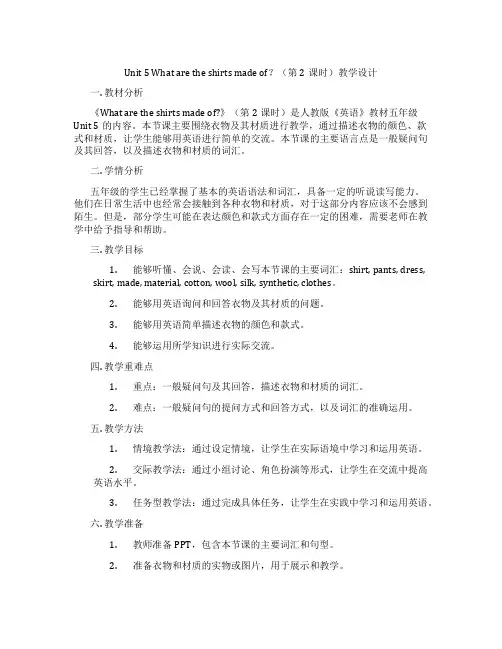
Unit 5 What are the shirts made of?(第2课时)教学设计一. 教材分析《What are the shirts made of?》(第2课时)是人教版《英语》教材五年级Unit 5的内容。
本节课主要围绕衣物及其材质进行教学,通过描述衣物的颜色、款式和材质,让学生能够用英语进行简单的交流。
本节课的主要语言点是一般疑问句及其回答,以及描述衣物和材质的词汇。
二. 学情分析五年级的学生已经掌握了基本的英语语法和词汇,具备一定的听说读写能力。
他们在日常生活中也经常会接触到各种衣物和材质,对于这部分内容应该不会感到陌生。
但是,部分学生可能在表达颜色和款式方面存在一定的困难,需要老师在教学中给予指导和帮助。
三. 教学目标1.能够听懂、会说、会读、会写本节课的主要词汇:shirt, pants, dress,skirt, made, material, cotton, wool, silk, synthetic, clothes。
2.能够用英语询问和回答衣物及其材质的问题。
3.能够用英语简单描述衣物的颜色和款式。
4.能够运用所学知识进行实际交流。
四. 教学重难点1.重点:一般疑问句及其回答,描述衣物和材质的词汇。
2.难点:一般疑问句的提问方式和回答方式,以及词汇的准确运用。
五. 教学方法1.情境教学法:通过设定情境,让学生在实际语境中学习和运用英语。
2.交际教学法:通过小组讨论、角色扮演等形式,让学生在交流中提高英语水平。
3.任务型教学法:通过完成具体任务,让学生在实践中学习和运用英语。
六. 教学准备1.教师准备PPT,包含本节课的主要词汇和句型。
2.准备衣物和材质的实物或图片,用于展示和教学。
3.准备颜色和款式的图片,用于描述衣物。
七. 教学过程1.导入(5分钟)利用PPT展示衣物的图片,引导学生谈论衣物。
例如:“Look at these clothes. Can you name them?”“What colors are they?”等。
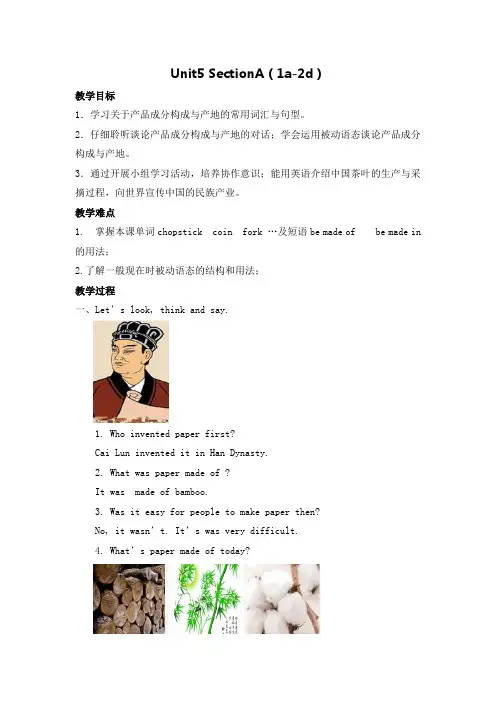
Unit5 SectionA(1a-2d)教学目标1.学习关于产品成分构成与产地的常用词汇与句型。
2.仔细聆听谈论产品成分构成与产地的对话;学会运用被动语态谈论产品成分构成与产地。
3.通过开展小组学习活动,培养协作意识;能用英语介绍中国茶叶的生产与采摘过程,向世界宣传中国的民族产业。
教学难点1. 掌握本课单词chopstick coin fork …及短语be made of be made in 的用法;2.了解一般现在时被动语态的结构和用法;教学过程一、Let’s look, think and say.1. Who invented paper first?Cai Lun invented it in Han Dynasty.2. What was paper made of ?It was made of bamboo.3. Was it easy for people to make paper then?No, it wasn’t. It’s was very difficult.4. What’s paper made of today?It’s made of wood, bamboo and cotton.1aWhat are these things usually made of? Match them with the materials. More than one answer is possible.1bListen and match the products with what they are made of and where they were made.Key pointsIs it made of silver??be made of 意为______________.be made of意为“由...制成”,能够看出原材料,be made from意为“由...制成”,看不出原材料,e.g. Glass ___________ glass.玻璃杯是由玻璃制成的。
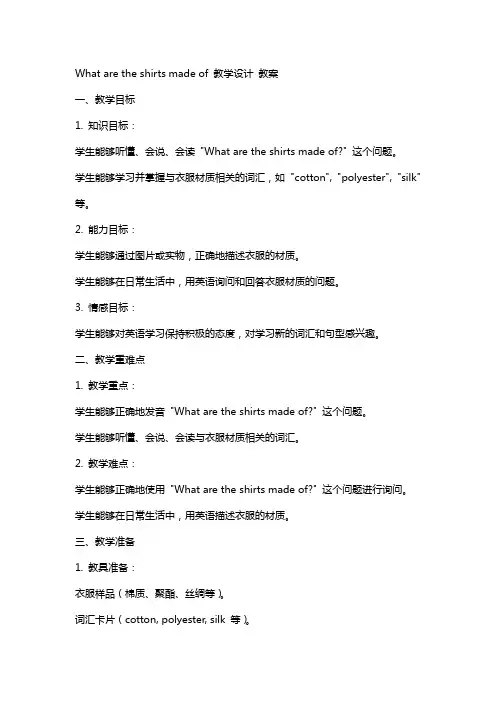
What are the shirts made of 教学设计教案一、教学目标1. 知识目标:学生能够听懂、会说、会读"What are the shirts made of?" 这个问题。
学生能够学习并掌握与衣服材质相关的词汇,如"cotton", "polyester", "silk" 等。
2. 能力目标:学生能够通过图片或实物,正确地描述衣服的材质。
学生能够在日常生活中,用英语询问和回答衣服材质的问题。
3. 情感目标:学生能够对英语学习保持积极的态度,对学习新的词汇和句型感兴趣。
二、教学重难点1. 教学重点:学生能够正确地发音"What are the shirts made of?" 这个问题。
学生能够听懂、会说、会读与衣服材质相关的词汇。
2. 教学难点:学生能够正确地使用"What are the shirts made of?" 这个问题进行询问。
学生能够在日常生活中,用英语描述衣服的材质。
三、教学准备1. 教具准备:衣服样品(棉质、聚酯、丝绸等)。
词汇卡片(cotton, polyester, silk 等)。
录音机或播放器。
2. 教学环境:教室里摆放着衣服样品,方便学生观察和学习。
四、教学过程1. 导入:教师向学生展示衣服样品,引导学生观察并猜测衣服的材质。
学生发表自己的猜测,教师给出正确的答案。
2. 新课呈现:教师出示"What are the shirts made of?" 这个问题的卡片,引导学生跟读并理解问题。
教师出示衣服样品,引导学生用"What are the shirts made of?" 这个问题进行询问。
3. 操练:教师组织学生进行小组活动,互相询问衣服的材质,并用英语进行回答。
教师选取一些学生的回答,进行展示和点评。
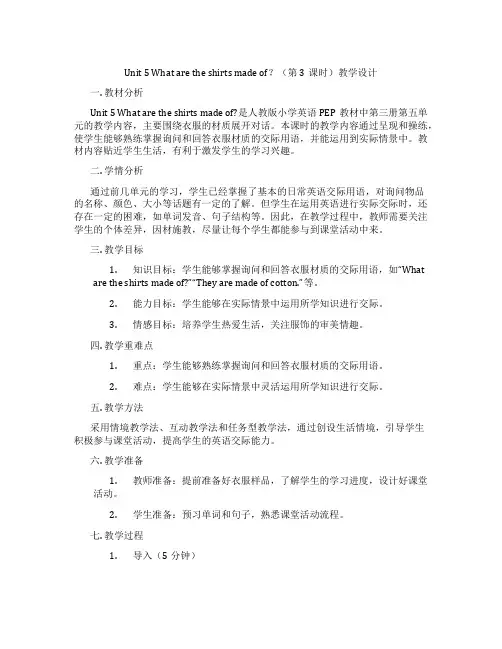
Unit 5 What are the shirts made of?(第3课时)教学设计一. 教材分析Unit 5 What are the shirts made of?是人教版小学英语PEP教材中第三册第五单元的教学内容,主要围绕衣服的材质展开对话。
本课时的教学内容通过呈现和操练,使学生能够熟练掌握询问和回答衣服材质的交际用语,并能运用到实际情景中。
教材内容贴近学生生活,有利于激发学生的学习兴趣。
二. 学情分析通过前几单元的学习,学生已经掌握了基本的日常英语交际用语,对询问物品的名称、颜色、大小等话题有一定的了解。
但学生在运用英语进行实际交际时,还存在一定的困难,如单词发音、句子结构等。
因此,在教学过程中,教师需要关注学生的个体差异,因材施教,尽量让每个学生都能参与到课堂活动中来。
三. 教学目标1.知识目标:学生能够掌握询问和回答衣服材质的交际用语,如“Whatare the shirts made of?”“They are made of cotton.”等。
2.能力目标:学生能够在实际情景中运用所学知识进行交际。
3.情感目标:培养学生热爱生活,关注服饰的审美情趣。
四. 教学重难点1.重点:学生能够熟练掌握询问和回答衣服材质的交际用语。
2.难点:学生能够在实际情景中灵活运用所学知识进行交际。
五. 教学方法采用情境教学法、互动教学法和任务型教学法,通过创设生活情境,引导学生积极参与课堂活动,提高学生的英语交际能力。
六. 教学准备1.教师准备:提前准备好衣服样品,了解学生的学习进度,设计好课堂活动。
2.学生准备:预习单词和句子,熟悉课堂活动流程。
七. 教学过程1.导入(5分钟)教师展示衣服样品,引导学生猜测衣服的材质,激发学生的学习兴趣。
如:“Can you guess what material this shirt is made of?”学生回答后,教师给出正确答案,并引入本课时的主题。
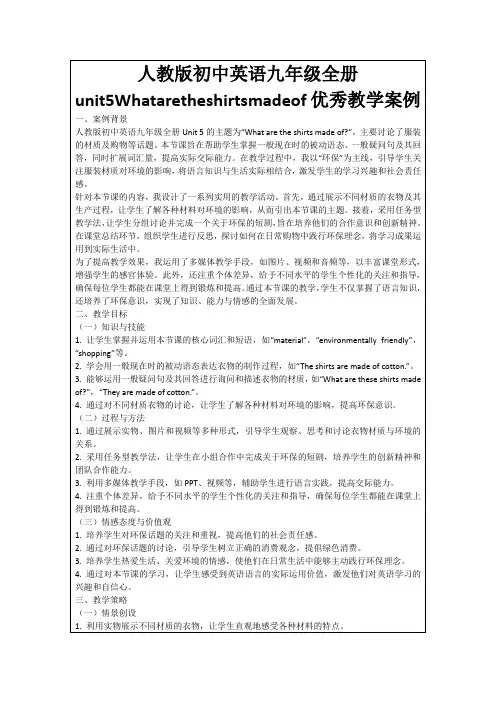
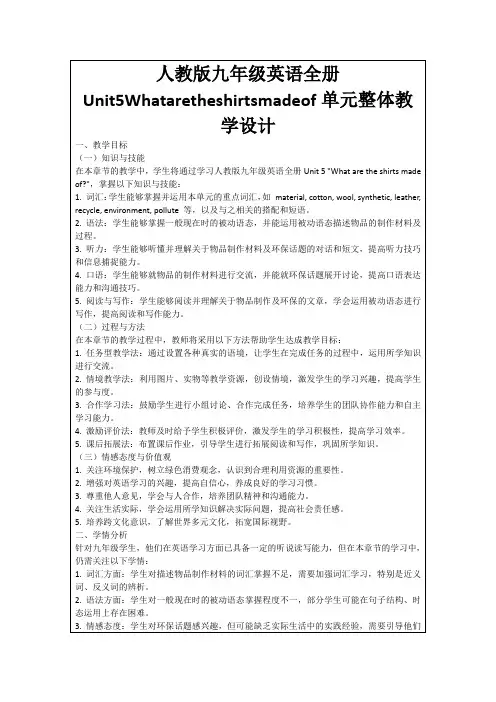
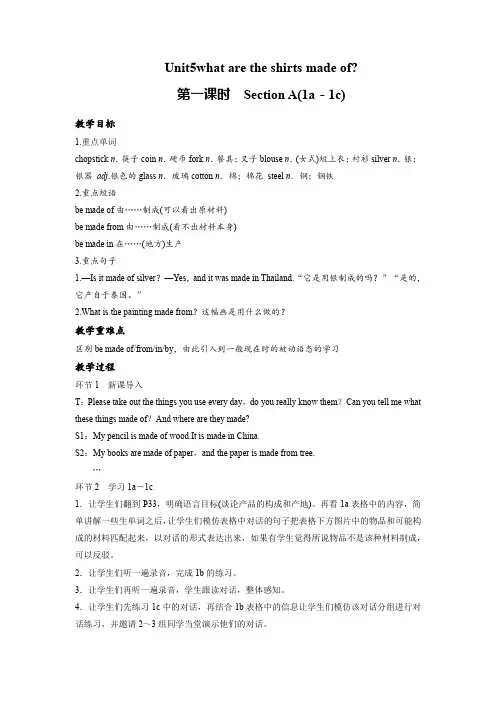
Unit5what are the shirts made of?第一课时Section A(1a-1c)教学目标1.重点单词chopstick n.筷子coin n.硬币fork n.餐具;叉子blouse n.(女式)短上衣;衬衫silver n.银;银器adj.银色的glass n.玻璃cotton n.棉;棉花steel n.钢;钢铁2.重点短语be made of由……制成(可以看出原材料)be made from由……制成(看不出材料本身)be made in在……(地方)生产3.重点句子1.—Is it made of silver?—Yes,and it was made in Thailand.“它是用银制成的吗?”“是的,它产自于泰国。
”2.What is the painting made from?这幅画是用什么做的?教学重难点区别be made of/from/in/by,由此引入到一般现在时的被动语态的学习教学过程环节1新课导入T:Please take out the things you use every day,do you really know them?Can you tell me what these things made of?And where are they made?S1:My pencil is made of wood.It is made in China.S2:My books are made of paper,and the paper is made from tree.…环节2学习1a-1c1.让学生们翻到P33,明确语言目标(谈论产品的构成和产地)。
再看1a表格中的内容,简单讲解一些生单词之后,让学生们模仿表格中对话的句子把表格下方图片中的物品和可能构成的材料匹配起来,以对话的形式表达出来,如果有学生觉得所说物品不是该种材料制成,可以反驳。
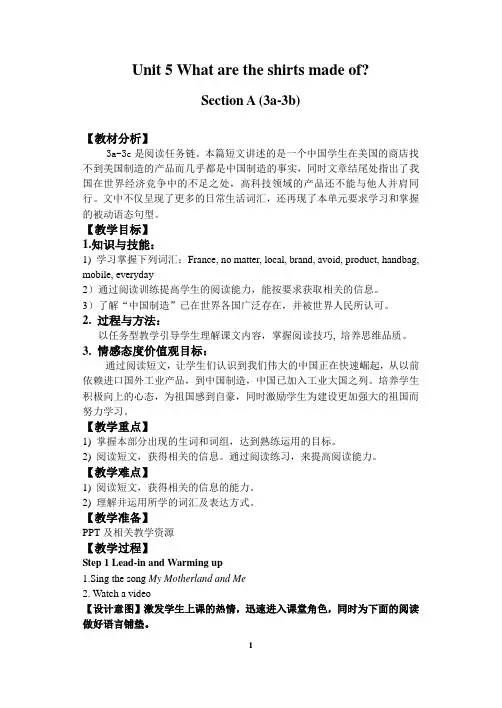
Unit 5 What are the shirts made of?Section A (3a-3b)【教材分析】3a-3c是阅读任务链。
本篇短文讲述的是一个中国学生在美国的商店找不到美国制造的产品而几乎都是中国制造的事实,同时文章结尾处指出了我国在世界经济竞争中的不足之处,高科技领域的产品还不能与他人并肩同行。
文中不仅呈现了更多的日常生活词汇,还再现了本单元要求学习和掌握的被动语态句型。
【教学目标】1.知识与技能:1) 学习掌握下列词汇:France, no matter, local, brand, avoid, product, handbag, mobile, everyday2)通过阅读训练提高学生的阅读能力,能按要求获取相关的信息。
3)了解“中国制造”已在世界各国广泛存在,并被世界人民所认可。
2. 过程与方法:以任务型教学引导学生理解课文内容,掌握阅读技巧, 培养思维品质。
3. 情感态度价值观目标:通过阅读短文,让学生们认识到我们伟大的中国正在快速崛起,从以前依赖进口国外工业产品,到中国制造,中国已加入工业大国之列。
培养学生积极向上的心态,为祖国感到自豪,同时激励学生为建设更加强大的祖国而努力学习。
【教学重点】1) 掌握本部分出现的生词和词组,达到熟练运用的目标。
2) 阅读短文,获得相关的信息。
通过阅读练习,来提高阅读能力。
【教学难点】1) 阅读短文,获得相关的信息的能力。
2) 理解并运用所学的词汇及表达方式。
【教学准备】PPT及相关教学资源【教学过程】Step 1 Lead-in and Warming up1.Sing the song My Motherland and Me2. Watch a video【设计意图】激发学生上课的热情,迅速进入课堂角色,同时为下面的阅读做好语言铺垫。
Step 2 PresentationLearn some new words.【设计意图】了解并检测学生预习单词的情况,为阅读扫清词汇障碍。
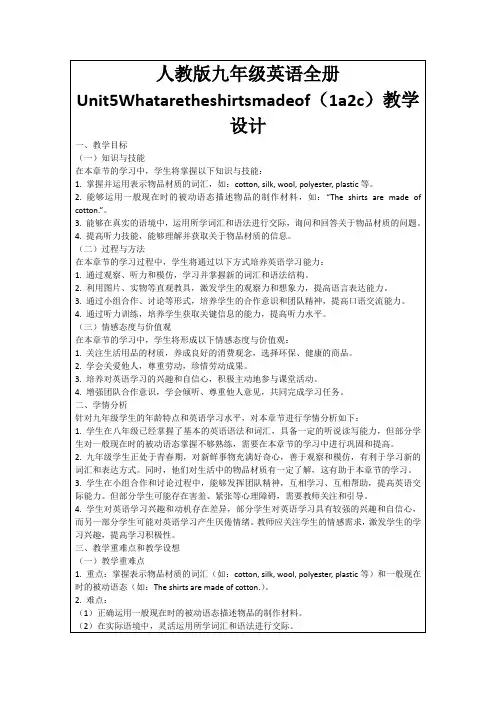
教案unit5 SectionA 1a-1c一.教学目标:(1)学习unit5 SectionA 1a-1c单词,表达。
(2)掌握be made of和be made in的用法。
熟练运用What be sth made of ? Where be sth made?对产品的材质和产地提问。
(3)通过教材上听力材料,提高学生听力水平。
二.教学重点:1.重点单词:chopstick,coin,fork,blouse,silver,glass,cotton,steel 2.重点短语:be made of,be made in3.重点句式:What are the shirts made of? Where were they made?—This ring looks nice. Is it made of silver?—Yes,and it was made in Thailand.三.教学难点:“主语+be made of…”“主语+be made in…”两种基本句型的特殊疑问句,一般疑问句,以及be动词的时态变化。
四:授课形式:听说课五.教学步骤:1.导入:呈现7张图片,然后让学生回忆勾出出现过的事物。
2.通过勾选的图片引出本单元要学习的生词,并补充对后面将会用到的词汇:Thailand Korea wood silver3.检测单词熟悉情况,对单词分类,介绍单词“material”4.引入重点短语be made of,并根据图片编对话。
5.完成1a的搭配,然后描述连线内容“……是由……制成的”6.引入短语be made in7.完成活动1b,练习听力并订正答案8.根据1b的内容编对话9.对话拓展,主要练习一般疑问句10.根据具体的事物较自由的编对话。
11.欣赏短视频,激发学生爱国热情12.完成练习,并讲解。
人教版九年级英语《Unit 5 What are the shirts made of?》教学设计一. 教材分析人教版九年级英语《Unit 5 What are the shirts made of?》是本单元的第一课时,主要介绍询问衣服材质的交际场景。
本课主要围绕衣服的材质、颜色和价格进行对话练习。
通过本节课的学习,学生能够掌握询问衣服材质的交际用语,并能用英语进行简单的购物对话。
二. 学情分析九年级的学生已经掌握了基本的英语语法和词汇,具备一定的听说读写能力。
但是,对于一些特定的交际场景和表达方式还不太熟悉。
因此,在教学过程中,教师需要关注学生的个体差异,充分调动学生的积极性,引导他们主动参与课堂活动。
三. 教学目标1.知识目标:学生能够掌握询问衣服材质的交际用语,如“What arethey made of?”、“They are made of…”等。
2.能力目标:学生能够用英语进行简单的购物对话,并能正确运用本节课所学词汇和句型。
3.情感目标:培养学生对英语学习的兴趣,提高他们的自信心和合作精神。
四. 教学重难点1.重点:掌握询问衣服材质的交际用语。
2.难点:正确运用所学词汇和句型进行购物对话。
五. 教学方法1.任务型教学法:通过设定购物场景,让学生在实际操作中运用所学知识。
2.交际法:引导学生进行pr work和group work,提高他们的口语表达能力。
3.游戏教学法:通过趣味游戏,激发学生的学习兴趣,巩固所学知识。
六. 教学准备1.教材:人教版九年级英语《Unit 5 What are the shirts made of?》2.多媒体设备:电脑、投影仪、音响等3.教学道具:衣服、价格标签等4.课件:制作与本节课相关的PPT课件七. 教学过程1.导入(5分钟)利用PPT展示一些衣服的图片,引导学生谈论衣服的款式和颜色。
教师提问:“What kind of shirts do you like?”、“What color do you like?”等,让学生用英语进行回答。
Unit 5 What are the shirts made of?Section A 1 (1a-2d)一、教学目标:1. 语言知识目标:1) 能掌握以下单词:chopsticks, coin, fork, blouse, silver, glass, cotton, steel, grass,leaf, produce, widely, be known for, process, pack 能掌握以下句型:①—This ring looks nice. Is it made of silver?—Yes, and it was made in Thailand.②What is it made of/from?③China is famous for tea, right?④Where is tea produced in China?2) 能够用英语描述及询问物品的制作材料,正确理解被动语态的用法及句子结构。
2. 情感态度价值观目标:了解一些日常用品的制成材料,增加生活常识,养成良好的生活习惯;了解一些地方知名产品或传统艺术品的制作过程以及制作材料,培养学生的民族自豪感及爱国主义精神。
二、教学重难点1. 教学重点:1) 掌握本课时中出现的生词2) 能够用英语描述及询问物品的制作材料3)正确理解被动语态的用法及句子结构。
2. 教学难点:理解被动语态的用法及句子结构。
三、教学过程Ⅰ. Lead in1. 播放动画片《造纸过程》的视频,让学生们了解这个中国传统发明的情况。
T: Who invented paper first?S1: Can Lun invented it in Han dynasty.T: What was paper made of then?S2: It was mainly made of bamboo.T: was it easy for people to make paper then?S1: No, it was very difficult then.T: What is paper made of now?S3: It’s mainly made of wood, bamboo, and cotton.…Ⅱ. Presentation1. Present the sentence structure, using the pictures on the big screen:—What’s the golden medal made of?—It’s made of gold.—Is this table made of wood?—No, it isn’t. It’s made of glass.—Is Butter made from meat?—No. It’s made from cream?让学生们学习掌握be made of/from句型的用法,及be made of与be made from的区别。
两词组都是“由……制成的”之意。
be made of 指从原料到制成品只发生了形状变化,没有发生本质变化(属物理变化)be made from指从原料到制成品发生了质的变化,已无法复原(属化学变化)。
Ⅲ. Learning1. Show some pictures on the big screen. Try to learn the new words using “be made of”structure.Learn the new words: chopsticks, coin, fork, blouse, silver, glass, cotton, steel, grass, leafe.g. This pair of chopsticks are made of bamboo.This coin is made of silver.Is this blouse made of cotton?No, it isn’t. It’s made of silk.What’s the fork made of?It’s made of steel.These pigs like grass very much.a piece of leafKolas like leaves.2. Ss discuss with their partner and try to learn the new words.3. Give Ss five more minutes to remember the new words.Work on 1a:Let Ss read the things and materials in 1a. Discuss with their partners and match them with the materials. More than one answer is possible.What are these things usually made of? Match them with the materials. More than one answer is possible.1.chopsticks2.window3.coin4.stamp5.fork6.blousea.woodb.goldc.silverd.papere.silkf.glassCheck the answers with the Ss.Ⅳ. Listening1.T: Tell Ss they will hear a conversation about some things and material. Listen andmatch the products with what they are made of and where they were made.2. Let one student read the words in the box, Play the recording for the Ss to listen.3. Ss try to listen and match the things with the material and here they were made.4. Play the recording again. Let Ss check the facts they hear.5. Check the answersⅤ. Pair work1. Read the conversation in the box in 1c.2. Ss try to made conversations using the information in 1b.e.g. A: Your new shirt looks very nice. Is it made of cotton?B: No, it isn’t. It’s made of silk.3. Let some pairs read out their conversations.Ⅵ. ListeningWork on 2a:T: Let’s listen to another conversation between Nick and Marcus.1. What are they talking about? First, let’s look at the pictures and the phrases in 1a.(Let one students read the phrases in 2a.)Listen and check ( √) the main topic of Nick and Marcus’ conversation.____ the science museum____ the art and science fair____ environmental protection____ a model plane____ a beautiful painting____ grass and leaves2. Play the recording for the Ss to listen and check the phrases.3. Play the recording again to check the answers.Work on 2b:1. Let Ss read the sentences below. Explain some main sentences for the Ss. Make sure they know what to do.2. Let Ss read the questions in 2b. Make sure they understand the meaning of each question.Play the recording for the Ss to answer the questions. (If necessary, using the pause button.)1) Where is the art and science fair?_________________________2) Do Nick and Marcus have to pay to go?_________________________3) What is the model plane made of?_________________________4) What is the painting made from?__________________________3. Play the recording again to check the answers.4. Play the recording again. Let Ss fill in the blanks of the conversation.Ⅶ. Pair work1. Tell Ss to make a conversation using the information in 2a and 2b.e.g.A: What did you see at the art and science fair?B: I saw a model plane.A: What is it made of?B: It’s made of steel, glass, and plastic.2. Let Ss make their own conversations.3. Practice their conversations in pairs.Ⅷ. Role-play1. Work on 2dRead the conversation and complete the blanks.1) Chinese _____________ tea both in the past and now.2) _________ I know, tea plants _________ on the sides of mountains.3) When the leaves are ready, they _______ by hand and then _______ for processing.4) The tea ____________ and sent to many different countries and places around China.5) People say that tea ___________ ____ health _____ business!2. Read the conversations and Let Ss read after the teacher.3. Explain some new words and main points in the conversation.4. Ask Ss to role-play the conversation in groups.X. Language points1. What is the model plane made of?What is the painting made from?be made of与be made from 辨析两词组都是“由……制成的”之意。